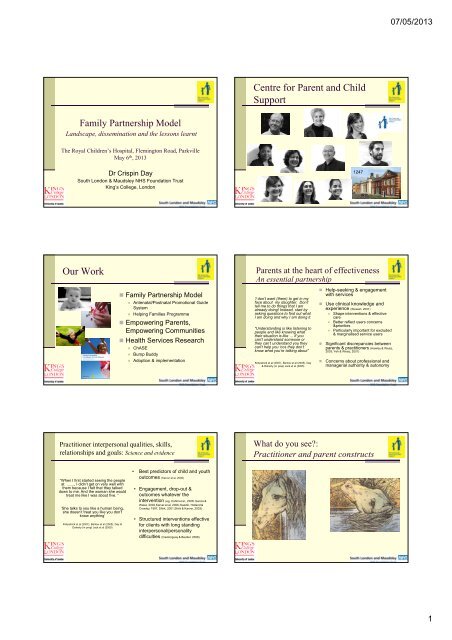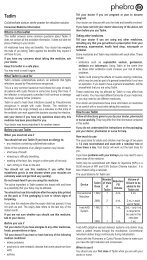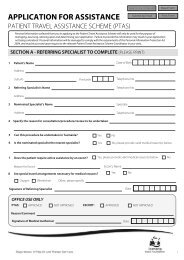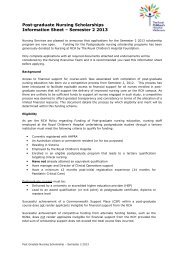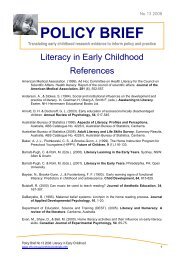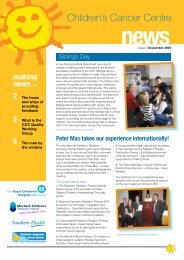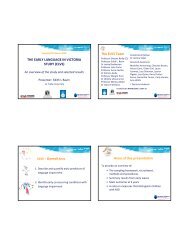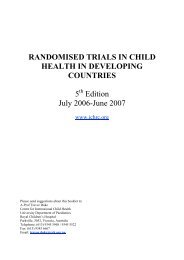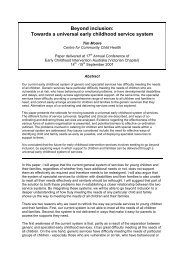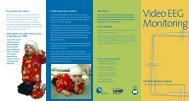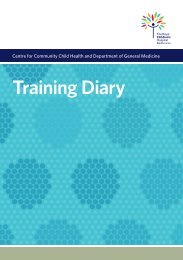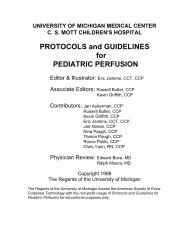Centre for Parent and Child Support Our Work - The Royal ...
Centre for Parent and Child Support Our Work - The Royal ...
Centre for Parent and Child Support Our Work - The Royal ...
You also want an ePaper? Increase the reach of your titles
YUMPU automatically turns print PDFs into web optimized ePapers that Google loves.
07/05/2013<strong>Centre</strong> <strong>for</strong> <strong>Parent</strong> <strong>and</strong> <strong>Child</strong><strong>Support</strong>Family Partnership ModelL<strong>and</strong>scape, dissemination <strong>and</strong> the lessons learnt<strong>The</strong> <strong>Royal</strong> <strong>Child</strong>ren’s Hospital, Flemington Road, ParkvilleMay 6 th , 2013Dr Crispin DaySouth London & Maudsley NHS Foundation TrustKing’s College, London1247<strong>Our</strong> <strong>Work</strong>• Family Partnership Model• Antenatal/Postnatal Promotional GuideSystem• Helping Families Programme• Empowering <strong>Parent</strong>s,Empowering Communities• Health Services Research• ChASE• Bump Buddy• Adoption & implementation<strong>Parent</strong>s at the heart of effectivenessAn essential partnership‘I don’t want (them) to get in myface about my daughter. Don’ttell me to do things that I amalready doing! Instead, start byasking questions to find out whatI am doing <strong>and</strong> why I am doing it.“Underst<strong>and</strong>ing is like listening topeople <strong>and</strong> like knowing whattheir situation is like … if youcan’t underst<strong>and</strong> someone orthey can’t underst<strong>and</strong> you theycan’t help you ‘cos they don’tknow what you’re talking about”Kirkpatrick et al (2007), Barlow et al (2005), Day& Doherty (in prep) Jack et al (2005)• Help-seeking & engagementwith services• Use clinical knowledge <strong>and</strong>experience (Stewart, 2001)• Shape interventions & effectivecare• Better reflect users concerns&priorities• Particularly important <strong>for</strong> excluded& marginalised service users• Significant discrepancies betweenparents & practitioners (Hawley & Weisz,2003; Yeh & Weisz, 2001)• Concerns about professional <strong>and</strong>managerial authority & autonomyPractitioner interpersonal qualities, skills,relationships <strong>and</strong> goals: Science <strong>and</strong> evidenceWhat do you see?:Practitioner <strong>and</strong> parent constructs“When I first started seeing the peopleat ......., I didn’t get on very well withthem because I felt that they talkeddown to me. And the woman she wouldtreat me like I was about five. “‘She talks to you like a human being,she doesn’t treat you like you don’tknow anything’Kirkpatrick et al (2007), Barlow et al (2005), Day &Doherty (in prep) Jack et al (2005)• Best predictors of child <strong>and</strong> youthoutcomes (Karver et al, 2006)• Engagement, drop-out &outcomes whatever theintervention (eg. Cahill et al., 2008; Garcia &Weisz, 2002,Karver et al, 2006; Kazdin, Holl<strong>and</strong> &Crowley, 1997, Shirk, 2001,Shirk & Karver, 2003)• Structured interventions effective<strong>for</strong> clients with long st<strong>and</strong>inginterpersonal/personalitydifficulties (Castonguay & Beutler, 2006)www.cpcs.org.uk1
07/05/2013Experiences, expectations & needs:<strong>Parent</strong>s <strong>and</strong> practitionersPractitioner qualities, skills <strong>and</strong>partnerships: Observations from practice• Active, feeling & thinkingpeople• Valued <strong>and</strong> respected• Beliefs, desires, motivations &priorities understood• Social & complexity gradient• Wider family <strong>and</strong> social circumstances(Kirkpatrick et al., 2007, Barlow et al., 2005; Jack etal., 2005; Day & Doherty, in prep)• Often not systematised inpractice – non-specific• <strong>Parent</strong>s’ experiences vary frompractitioner to practitioner• Practitioners’ experiences vary<strong>for</strong>m parent to parent• Assumptions aboutpractitioner skills <strong>and</strong> effects• Underestimates• Overestimates• <strong>Parent</strong>s’ & family views notsystematically sought or actedupon in practice• Avoid drift <strong>and</strong> maintain focusFamily Partnership Model:Evidence-based, goal-orientated practice<strong>The</strong> Family Partnership ModelConcepts & Evidence• Multiple, personalised goals &outcomes• Ecological model of child <strong>and</strong> familydevelopment• Future, goal-orientated• Family hopes & aspirations withpractitioner expertise• Family strengths <strong>and</strong> expertise not blindoptimism• Explicit, structured helping process• Practitioner skills, qualities, roles &knowledge• Service & community context(FPM, Davis & Day, 2010)Family Partnership ModelFPM evidence base:Outcomes tested through research• <strong>Parent</strong>s of children with severe <strong>and</strong>multiple disabilities (Davis & Rushton, 1991), RCT110105InterventionPartnership• <strong>Parent</strong>s of children with emotional <strong>and</strong>behavioural difficulties (Davis & Spurr, 1998), CT1009590ComparisonHelper QualitiesHelper SkillsCharacteristics of <strong>Parent</strong>s <strong>and</strong><strong>Child</strong>renHelpingProcessService & Community ContextOutcomesConstruction Processes• Preterm infants (Avon Premature Infant Project, 1998)RCT• Promotion of early parental adaptation<strong>and</strong> infant outcomes (Davis et al., 2005; Puura et al.,2005) CT• Prevention of childhood neglect <strong>and</strong>abuse (Barlow et al., 2003; Barlow et al., 2007; Brocklehurst etal., 2004, Kirkpatrick et al., 2007) RCT• Maternal Early <strong>Child</strong>hood SustainedHome-visiting (MECSH, Kemp et al., 2011) RCT857573716967656361595755Time 1 Time 2Time 1 Time 2CBCL Total ScoreInterventionComparison2
07/05/2013FPM Outcomes: A personalised &multi-dimensional approach<strong>The</strong> FPM Helping ProcessCompensate wherenecessary, eg.riskEnable multiagencysupport/serviceinvolvementFacilitate family,social & communitysupportDo no harm<strong>Child</strong>ren&FamiliesFoster resilience &problem anticipationFPM OutcomesClarify & manageproblemsBuild parents’strengths & abilitiesFoster development& well-being ofchildren• Applicable across differentproblems & difficulties• Reflects complexity of real lives• Numerous outcomes comparedwith a singular disorderapproach• Need to focus on key realisticoutcomes, hopes & aspirations• Clear about purpose of helping• Confident in strategies,progress <strong>and</strong> effectivenessPartnershipBuild & sustainExplorationUnderst<strong>and</strong>ingGoal SettingStrategy PlanningImplementationReviewEndingOUTCOMESSpontaneousUnpredictedBroadOUTCOMESFocusedIntendedPlannedRelationships with parents:FPM partnership <strong>and</strong> rolesFPM Partnership in practice:Attitude, role & behaviour• Expert• Friendship• Dependent• Adversarial• Avoidant• Partnership• Being supportive• To sustain, encourage, care & shore up• Being connected• To hit off, hook up with <strong>and</strong> to get along• Being facilitative• To make possible, make easy, to makehappen• Being influential• To have some bearing on, to inspire <strong>and</strong> tochange• Being purposeful• To be focussed, determined <strong>and</strong> persistent• Active & mutual participation/involvement• ‘giving <strong>and</strong> receiving’ rather than‘knowing <strong>and</strong> telling’• Complementary influence, expertise &roles• Share open decision-making power notequal• Share aims <strong>and</strong> process of helping <strong>and</strong>intervention• Agreements <strong>and</strong> disagreements• Avoid shift to expert judgement(Davis & Day, 2009, 2010; Day & Davis, 2009)FPM: Essential qualities of the helper• Respect & acceptance• Empathy & underst<strong>and</strong>ing• Genuine warmth & enthusiasm• Humility & realism• Personal strength & integrity• Belief in <strong>and</strong> commitment toparents’ & children’s futures• Constructive & supportivejudgment• Emotional & intellectualattunement• Facilitate & influence rather th<strong>and</strong>irect & controlFPM: Skills of helpers• Listening, communication <strong>and</strong> partnershipskills• Concentration/active listening• Prompting, exploration <strong>and</strong> summarising• Empathic responding• Enthusing <strong>and</strong> encouraging• Ability to communicate openly & challenge constructively• Being purposeful <strong>and</strong> focused• Helping parents to change their feelings,ideas <strong>and</strong> actions• Generating hope <strong>and</strong> motivation• Exploring constructs• Prioritisation & goal setting• Strategy planning, selection & implementation• Review progress• Technical expertise• Use parents’ strengths & resources• Problem/disorder-specific intervention knowledge <strong>and</strong> skills• Sharing knowledge <strong>and</strong> expertise in underst<strong>and</strong>able,meaningful <strong>and</strong> useful way(eg. Egan, 1990; Karver et al, 2006)3
07/05/2013Family Partnership Model:<strong>The</strong> underpinning skills <strong>and</strong> qualities• L• E• S• S• SFPM Skills & Qualities:In the eye of the beholder• Listened to <strong>and</strong> heard• Empathised with <strong>and</strong>appreciated• Summarise parent experiences<strong>and</strong> priorities• Shared underst<strong>and</strong>ing ofstrengths, concerns, goals &process• Strategies <strong>and</strong> actionsplanned, implemented <strong>and</strong>reviewedFPM Training <strong>and</strong> sustained practice<strong>The</strong> Family Partnership ModelAdopting FPM Practice• FPM manualised evidence basedtraining• Foundation• Supervisor• Facilitator• Reflective practice h<strong>and</strong>book &practice tools• Strategic <strong>and</strong> operationalrequirements• UK Community of Practice• Close partnership with Australianstates <strong>and</strong> territories• 1000s of practitioners trainedBring FPM AliveAdoption in four steps (Kirkpatrick, 1994)FPM Foundation training:Research <strong>and</strong> evaluation outcomes<strong>Child</strong> <strong>and</strong> family outcomesDegree of theory‐practiceintegrationPractitionerknowledge acquisitionPractitionerreaction<strong>and</strong>satisfaction806040200Know Confd Equip CommittPartnership building806040200Not at all Little Some Moderate Great dealBe<strong>for</strong>e(0-100)After(0-100)• More than 90% recommendtraining (CPCS, 2008; Jackiewicz, 2004)• Sig. improvement in practitionerskills, qualities <strong>and</strong> self-efficacy(Rushton & Davis, 1991, Davis et al., 1997)• More accurate at identifying familyneeds (Papadopoulou et al, 2005)• Significant improvements in FPMknowledge, commitment &confidence (About FPM, p=.000, Day, 2007)• High levels of knowledgeacquisition in core FPM concepts<strong>and</strong> skills4
07/05/2013What it takes• Engage the mind <strong>and</strong> the heart but nottake it personally<strong>The</strong> Family Partnership ModelPractice Integration, Challenges & Dilemmas• Redefine & manage professionalexpertise, <strong>for</strong> example:• Become a partner by relinquishing expert role• Listen <strong>and</strong> exercise restraintt• Facilitate the Helping Process rather than give advice<strong>and</strong> solutions – the righting reflex• Personal strength to openly examinepractice:• Learn from doing, learn from practice, learn fromparents <strong>and</strong> learn from peers• Manage the desire to guard, protect <strong>and</strong> reaffirmexisting knowledge, constructs <strong>and</strong> skills(Fowler et al., 2012, Harris & Day, 2013, Rossiteret al., 2013, Hopwood et al, 2013, )FPM Practice: Challenges• Doubtful• Uncertain, hesitant, lackingconfidence• Reactive• Impulsive, instinctive,unconsidered• Laissez-faire• Ever-changing, unpredictable,improvised• Selective• Parts not whole• Fixed• Rigid, inflexible, unbending• Frozen• Stuck, trapped, frozen in pastexperienceLiving FPM Practice:Effective, quality, fidelity & enjoyment• Alive & alert• Flexible & considered• Confident, consistentconstructs & practice• Know practitioner strengths• Purposeful partnership <strong>and</strong>quick wins• Use FPM practice tools <strong>and</strong>Reflective PracticeH<strong>and</strong>book• Manage practice dilemmasDilemmas in FPM Practice:FPM Practice Tools:Sharing the tasks <strong>and</strong> the partnershipIt’s fun to benice but if youare ineffective,‘being nice’ isworthless. Youhave got to bemore than nice’• Influencing <strong>and</strong> challenging parentswithout risking the partnership• Relationship <strong>and</strong> capacity <strong>for</strong> changeconstrued as fragile• To go beyond ‘being nice’• Maintaining focus <strong>and</strong> momentum<strong>and</strong> still being parent led• <strong>The</strong> complexity of families’ lives &difficulties• Using practitioner expertise whileworking in partnership• <strong>Parent</strong>-led or practitioner led, trying not tobe an expert(Fowler et al., 2012, Harris & Day, 2013, Rossiteret al., 2013, Hopwood et al, 2013, )• Aim & Goal Stars• Exploration using PromotionalGuides• Strategy planning together• Implementation• Putting it into practice• Recipe <strong>for</strong> success• Review tools• Goal star• <strong>Parent</strong> feedback• Multiagency tools5
07/05/2013FPM Promotional Guide System:Guided exploration & underst<strong>and</strong>ingFPM Promotional Guide &Prompt CardsFPM Practice Tools: Sharing the tasks &living the partnership• Openness about FPM <strong>and</strong>helping process from the start• Explicit reminder of content &process of FPM• Clear summary of key FPMcontent & process• Keep on track <strong>and</strong> rein<strong>for</strong>cepurpose• 3 rd space between parent <strong>and</strong>practitioner• For parent <strong>and</strong> practitioner tokeep<strong>The</strong> Family Partnership ModelSustaining living practiceGrowing <strong>and</strong> Sustaining FPM inPractice: Model features• FPM practice & serviceconditions are inextricablybound together• FPM has to be a clearlydescribed & replicable• Coherent methods <strong>for</strong>dissemination, adoption <strong>and</strong>sustained implementationnot train <strong>and</strong> hope• Training programmes• Practice tolls• Reflective practice h<strong>and</strong>book(Greenhalgh et al., 2004)6
07/05/2013FPM Reflective practiceh<strong>and</strong>book• Summarises FPM• Contact structure• Summary sheets <strong>and</strong>reflective practice sheets• Complete after everycontact• Personal/team reflection• Bring to supervision <strong>for</strong>discussionGrowing <strong>and</strong> Sustaining FPM inPractice: Service features• FPM has to have clear clinical<strong>and</strong> service advantages• Resources & support <strong>for</strong> FPMthroughout the organisation• Practitioner time, resources &commitment,• Practice tools to supportimplementation• <strong>Support</strong> & supervision, peers& managers• Clear evidence of FPM value,outcome & effect• Multiple & varied evidence(Greenhalgh et al., 2004)Sustained implementation ofFPM: Practitioner views• Strong practitioner support <strong>for</strong> FPM• 87.0% FPM will make them moreeffective• 82.0% Families will benefit from FPM• 76.0% Practitioners will regularly useFPM• Practitioners are less certain aboutmanagerial support• 62.0% Active support from manager• 50.5% Senior manager championedFPM• 36.2% Manager allocated time <strong>and</strong>resources• 26.7% Receive regular supervisionFPM Sustainability: An example• 3 yr programme• Began with initial visit to meet seniormanagers• FPM Foundation training <strong>for</strong> seniorpractitioners• Multidisciplinary group with personal<strong>and</strong> professional impact• Trained FPM supervisors• High impact – set up reflectivepractice meetings• Trained FPM facilitators• High impact – identify key pracs totrain <strong>and</strong> organised plan <strong>for</strong>achieving take-up• Stories of impact disseminatedacross organisation• Open <strong>and</strong> non defensive approachby practitioners• Assistant Director champion• <strong>Support</strong> from senior clinicians• Consistent with policy <strong>and</strong> serviceaims• Identified resources <strong>and</strong> money• Set up Family partnership team• Change in documentation <strong>and</strong>procedures of practice• In<strong>for</strong>mal diffusion by AD <strong>and</strong> otherchampions• Training certificates h<strong>and</strong>ed out byCEO• Regular, active <strong>and</strong> goodrelationship with CPCS• Press coverageFPM L<strong>and</strong>scape & Dissemination:Lessons learnt• FPM is an effective evidencebased model• Explicit. open <strong>and</strong> sharedpractice• Achieves effective outcomes <strong>for</strong>families• Excellent initial adoption <strong>and</strong>well supported by practitioners• Requires sustained, collectiveorganisational cultivation to live<strong>and</strong> be sustained7


